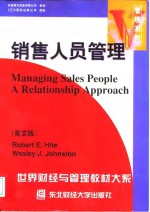
- 作 者:(美)罗伯特·E.海特(RobertE.Hite),(美)威斯利·J.乔斯敦(WesleyJ.Johnston)著
- 出 版 社:沈阳:东北财经大学出版社
- 出版年份:1998
- ISBN:7810443933
- 标注页数:589 页
- PDF页数:609 页
请阅读订购服务说明与试读!
订购服务说明
1、本站所有的书默认都是PDF格式,该格式图书只能阅读和打印,不能再次编辑。
2、除分上下册或者多册的情况下,一般PDF页数一定要大于标注页数才建议下单购买。【本资源609 ≥589页】
图书下载及付费说明
1、所有的电子图书为PDF格式,支持电脑、手机、平板等各类电子设备阅读;可以任意拷贝文件到不同的阅读设备里进行阅读。
2、电子图书在提交订单后一般半小时内处理完成,最晚48小时内处理完成。(非工作日购买会延迟)
3、所有的电子图书都是原书直接扫描方式制作而成。
Brief Table Of Contents 1
PART Ⅰ 1
Understanding the Sales Force Environment 1
CHAPTER 1 Selling: Past, Present,and Future 2
CHAPTER 1 Selling: Past, Present, and Future 2
BUILDING RELATIONSHIPS: CUSTOMER RELATIONSHIP 3
Introduction 4
A Historical Perspective on Personal Selling 4
The Past 4
The Present and Future 5
Summary 9
Review and Discussion Questions 10
CHAPTER 2 The Sales Environment 12
CHAPTER 2 The Sales Environment 12
BUILDING RELATIONSHIPS: ETHICS AND SALES MANAGEMENT 13
Introduction 14
Legal Issues 16
Specific Legal Concerns 17
Ethical Issues 29
Creating Ethical Corporate Structures 30
Relationships with Customers 32
Relationships with Competitors 33
Relationships with Company 34
Relationships with Society 35
Summary 36
Key Terms 36
Review and Discussion Questions 37
Cases 37
CHAPTER 3 International Sales Force Management 40
CHAPTER 3 International Sales Force Management 40
BUILDING RELATIONSHIPS: JAPANESE APPROACHES TO INTERNATIONAL MARKETS 41
Marketing Intermediaries 42
Developing an International Soles Force 42
Introduction 42
Organizing the International Sales Force 47
Corporate Influences on International Sales Force Organization 48
Industry Influences on International Sales Force Organization 48
Recruitment and Selection 49
Managing the International Sales Force 49
Environmental Influences on International Sales Force Organization 49
Training 52
Motivation and Compensation 53
Negotiating the Sale 53
Differences in International Negotiating Styles 54
Differences in Decision Making 56
Status and Protocol 57
Social Aspects of International Negotiations 57
Personal Relationships 58
Perceptions of Time 58
Additional Specifics on Countries, Regions, and Cultures 59
Summary 64
Key Terms 65
Review and Discussion Questions 65
Cases 65
CHAPTER 4 Organizing the Sales Force 68
CHAPTER 4 Organizing the Sales Force 68
BUILDING RELATIONSHIPS: SALES SUPPORT TEAMSSS 69
Introduction 70
Theories of Organization 70
The Classical or Traditional Theory 70
Neoclassical Theory 70
Modern Organization Theory 70
The Dilemma 72
Basic Guidelines for Good Organization 73
Division of Work 73
The Line Organization? 74
Change 74
Span of Management? 74
Types of Organization 74
The Line and Staff Organization 76
The Functional Organization 77
The Centralized versus the Decetralized Organization 78
Organizing by Specialization 79
Inside Salespeople 87
Independent Representives 88
Organizational Procedures 89
Organizational Expectations 90
Managing in the Twenty-First Century 90
Summary 92
Key Terms 93
Review and Discussion Questions 93
Cases 93
PART Ⅱ 97
Planning for Sales 97
CHAPTER 5 Automating the Sales Force 98
CHAPTER 5 Automating the Sales Force 98
BUILDING RELATIONSHIPS: COMPUTERIZED SALES SUPPORT 99
Introduction 100
Increasing Productivity 101
Sales AnaLysis 102
Territory Management 102
Components of SaLes Force Automation Systems 102
Telemarketing 103
Teleprospecting 105
Sales Presentations 106
Disk-Based SaLes Presentations 107
Sales Proposals 109
Computerized Ordering 110
Electronic Data Interchange 110
Implementation 111
The Pilot Program 111
Software 113
Hardware 114
Implementation Pitfalls 117
Summary 118
Key Terms 120
Review and Discussion Questions 120
Cases 120
The Importance of Accurately Forecasting Market Potential 121
CHAPTER 6 Sales Forecasting 124
CHAPTER 6 Sales Forecasting 124
The Terminology of Forecasting 126
Why a Sales Forecast I26 126
Introduction 126
Sales Force Composite 128
Nonquantitative Techniques for Forecasting Sales 128
Jury of Executive Opinion 130
Quantitative Techniques for Forecasting Sales 133
Trend Projections 133
Fitting a Trend Line 134
Moving Averages 136
Exponential Smoothing 137
